But when we fetishise historical underwear – that is, focus obsessively on it as an object and imbue it with an almost magical meaning – we lose perspective on what it was like to wear these garments on an everyday basis. It's very difficult to view images of the past without bringing our own fetishes to them (Indeed, our ideas of how to wear and comport ourselves in old-fashioned underwear often come from our own narratives set in the past and vintage fetish imagery), or misreading historical fetishes as objective truths about the past. We should aim to tread a middle path.
When we think of 'sexy underwear', for instance, it seems commonsensical to wear a garter belt over underpants, as Dita von Teese does here:

But in pinup illustrations and vintage 'naughty postcards', we often see the undies worn over the garter belt so the suspenders emerge from beneath, as in this 1969 Gil Elvgren illustration:

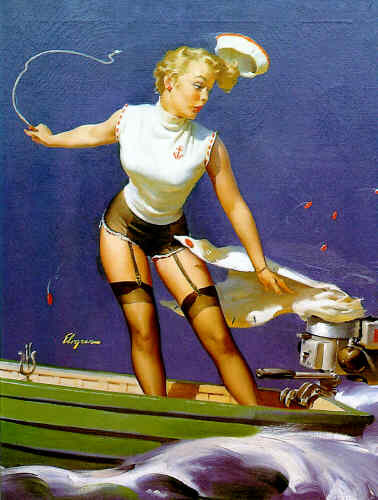
And this one, from 1954. Elvgren's girls always have such hilarious wardrobe malfunctions involving their skirts getting ripped off, stuck in machinery, or snagged on fences and nearby trees…
From the shoes, the images below seem to be from the 1920s or 1930s. Stockings from this era are also, apparently, quite recognisable for the sheen they give the legs; this is when semi-synthetic 'artificial silk' appeared; it was renamed Rayon in 1927. Nylon didn't come in until 1940.
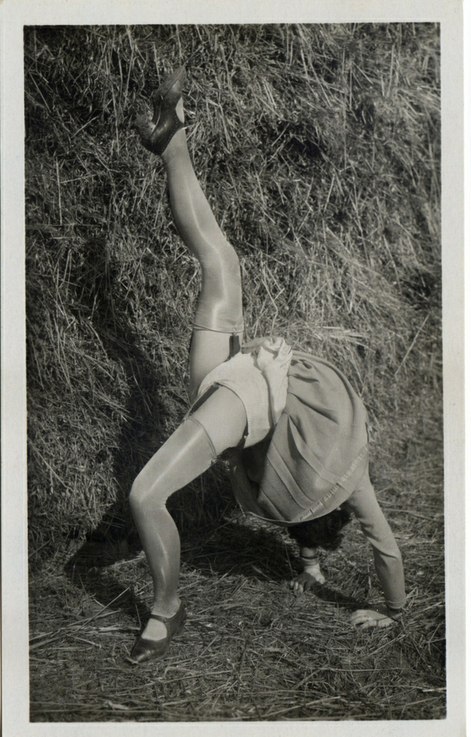
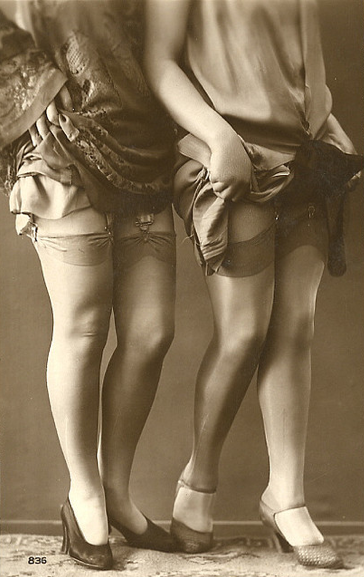
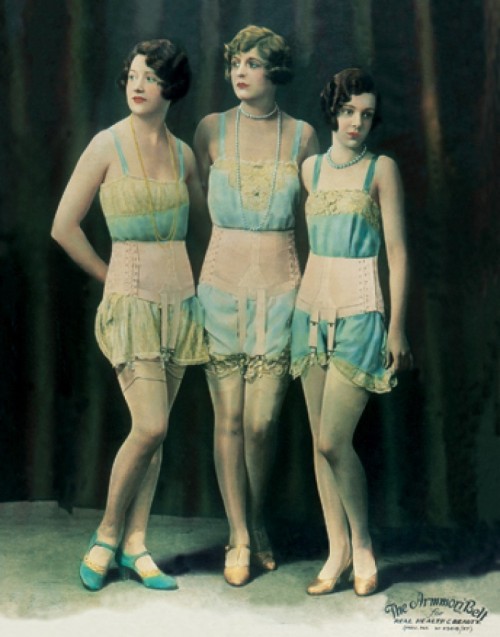
Here, we see a corset modelled over the top of the chemise or camiknickers, with attached suspenders. Also, notice how the purpose of the corset is not to cinch the waist but to slim and smooth the abdomen and hips. Speaking of corsets, these days they tend to be worn as an alluring undermost garment:

…but back in the day, when corsets were everyday items, you wouldn't do that because you would sweat into your expensive corset or get chafing, even abrasions. A chemise was always worn underneath, as in this image from the 1900s.

Note how the suspenders attached to the corset bunch up the chemise.
Blogger and US Civil War re-enactor Scott B Lesch noticed that his female colleagues were wearing their drawers under their shifts, as we might wear underpants under a slip. But he unearthed quite a few archival references to the earlier practice of tucking one's shift into one's drawers (which had no crotch seam; they were only attached to the waistband, so ladies could relieve themselves without getting undressed).
If you weren't careful, or the chemise was too long, it poked out the back and your little brother laughed at you:

At this time, stockings were held up with leg garters rather than suspenders, which were hidden under the chemise and drawers.
The trouble with using naughty postcards as source material is that they probably do depict sexually fetishistic practices from the time they were photographed. Take this image, for instance:

Whether or not it has been airbrushed, it almost certainly depicts a participant in a tight-lacing fetish culture. We're tempted to claim that everyone in "the Victorian era" tight-laced – mainly because of the moral panic media coverage about it at the time – but it was only a niche practice. We marvel at the tiny waist dimensions of corsets in museums, but of course they were seldom worn completely closed. Besides, women's bodies were trained to wear corsets from a very early age.
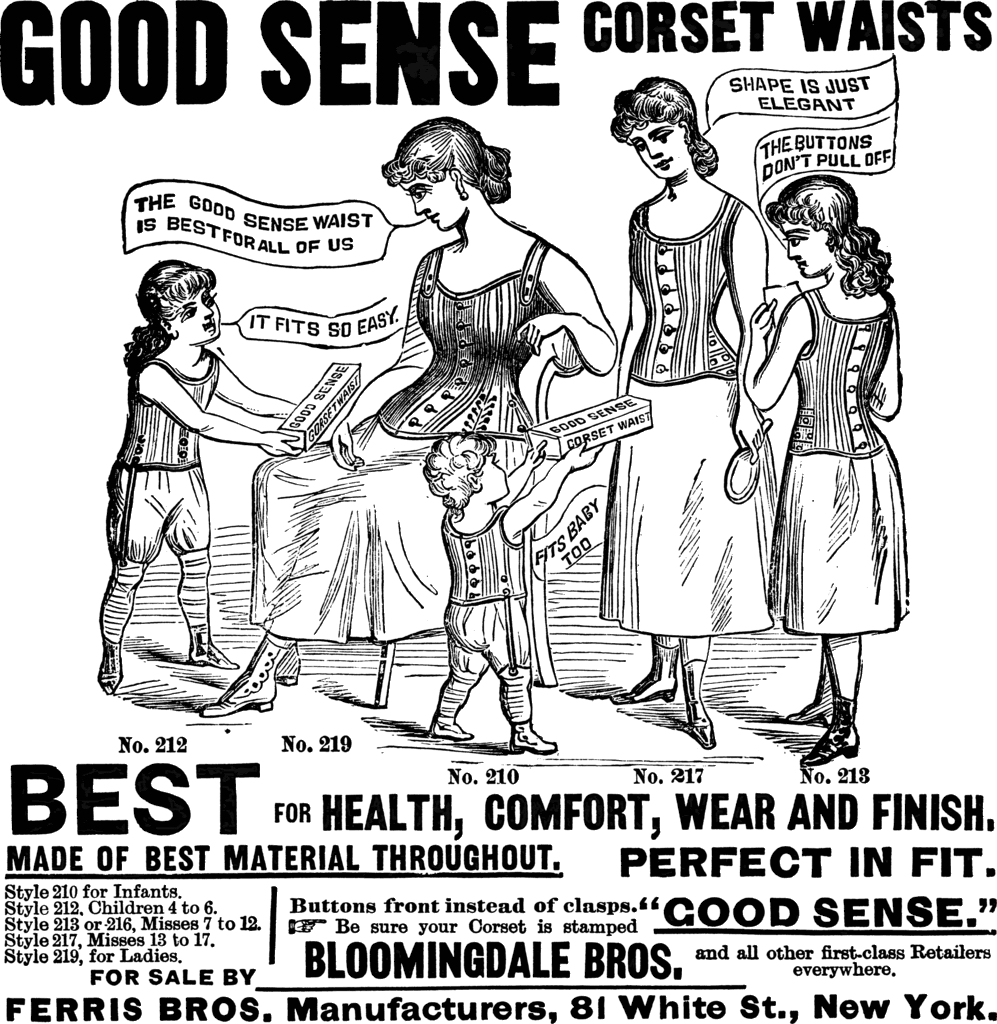
Meanwhile, advertisements for underwear speak so conspicuously of comfort and fit that we should be skeptical that they really depict the lived experience of wearing the underwear. A slightly different picture emerges when we look at the 'toilette' genre of art, which was basically an excuse for painters to depict women in attractive states of déshabillé.
While some of these paintings depict the fashion that began in pre-revolutionary France to invite people over to hang out and gossip with you while you got dressed, others depict women in a dreamy, vulnerable state somewhere between nudity and social visibility.

Woman at Her Toilette, Edgar Degas, 1876-77
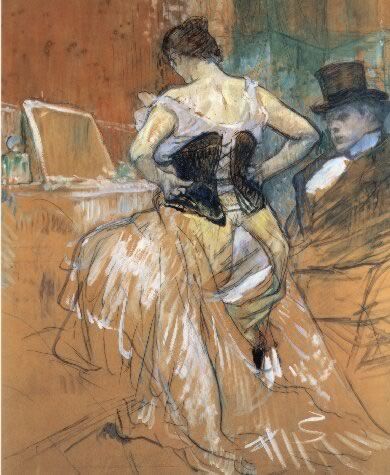
Femme à la Toilette, Henri de Toulouse-Lautrec, 1896.

La Toilette, Georges Croegaert, 1891
They also offer information about how and in which order garments were donned. In Pietro Longhi's Lady at the Toilette (1736), we see the decorative petticoat, neckline and sleeves that will end up peeping from the pink outer dress her maid is holding out.


But if we are to believe Nicolas-René Jollain's La Toilette, the hat always went on first.
1 comment:
Hi Mel, love these images. Dita Von Teese has the suspender belt the wrong way round - it was usually worn under the knickers for ease of toilet visits. Believe it or not, I had to wear stockings and suspender belt as a young girl - panty hose weren't widely available until the mid to late 60s and were pretty expensive initially. Another delightful undergarment of my youth was the girdle - a corset device that encased the hips and derriere, with suspenders attached. This was truly an uncomfortable garment, marginally improved in the panty girdle. It's interesting to reflect on the changing silhouette, from the hour glass waist, to the flattened hips and stomach. Thank goodness for modern comfortable underwear! Cheers, Ro
Post a Comment